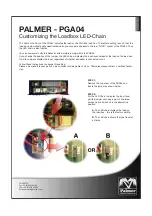
5
4
Unit and Flask Set-up
Lightly spray the Corning® MicroDEN® unit and consumable set with 70%
ethanol and place inside the biosafety cabinet. Remove the flasks and
thermoform from the packaging and place the tray on the unit. Flasks and
components are pre-assembled. Inspect that all connections are tight and
secure. Inspect for any creased tubing that may inhibit flow.
5. Cell Seeding
Cells can be seeded into the Corning MicroDEN flasks by either (Method 1)
positive pressure using a pipettor or (Method 2) pump perfusion.
1. Suspend enriched MOs in 25.0 mL of differentiation medium.
2. Remove the seeding bottle from the tray.
3. Open the bottle.
◗
–
To unscrew the cap, turn the bottle while keeping the cap and tubing set in
place so the tubes don’t twist. Take care not to touch the dip tubes to any
non-sterile surface (Figure 1).
4. Pipet cell solution into the seeding bottle.
5. Insert tubing set and cap back onto the bottle. While pressing down on the
tubing set, rotate the orange cap to tighten the assembly to the bottle
(Figure 1). Place the bottle back into the thermoform tray.
4. Setting up the Corning® MicroDEN® Unit
The Corning MicroDEN unit requires working within a biosafety cabinet to
maintain sterility. The following protocol is for seeding enriched monocytes
(MOs).
Overview
The differentiation of MOs to dendritic cells is a multi-day process that involves
seeding enriched MOs into 2 single-use flasks followed by a medium refresh
on Day 3 and dendritic cell harvest on Day 6. Duration may be increased or
decreased depending on preference. Perfusion volume requirements should be
adjusted accordingly.
The set-up process involves transferring the unit and consumables between the
biosafety cabinet and incubator. Care should be taken to ensure the unit and
consumables are handled properly (avoid aggressive motions such as dropping
and/or hitting against a wall) to prevent disturbing the cultured cells.
The cell culture flasks may be seeded with either enriched MOs or with
peripheral blood mononuclear cells (PBMCs) where the MOs are enriched
through plastic adherence. The following protocol is based on seeding enriched
MOs, but the process can be amended for seeding PBMCs and enriching MOs
through plastic adherence.
A base medium compatible with dendritic cell generation should be used,
although this is not a requirement for proper function of the unit and
consumable. Differentiation medium consists of base medium plus the
cytokines IL-4 and GM-CSF to facilitate differentiation of MOs into immature
dendritic cells (iDCs). Generated iDCs can subsequently be matured in the same
flasks, if desired. Each flask has a volume of 13.2 mL and a cell culture area of
39.7 cm
2
. 80 mL of differentiation medium is added to the inlet bottle on set-up
(Day 0) and Day 3. The recommended cytokine concentration of differentiation
medium is 350 U/mL, although this can be changed based on user preference.
The Corning MicroDEN unit has four pre-programmed flow rates:
1. Seeding (6.50 mL/min.)
2. Prime (6.50 mL/min.)
3. Culture (8.0 µL/min.)
4. Harvest (13.50 mL/min.)
The following protocol assumes a 6-day differentiation, thus inlet bottle
volumes are given for 3-day intervals. For example, 3 days of perfusion at 8.0
µL/min./flask will require 80 mL of differentiation medium (70 mL for perfusion
plus 10 mL excess). Users should optimize the process for their particular
cell type and objectives. The volume of differentiation medium added to the
inlet bottle should be adjusted based on duration of run and media refresh
requirements. During culture, medium flows from the inlet bottle, through the
flasks, and into the outlet bottle. The outlet bottle does not need to be emptied
for a 6-day run, but the outlet bottle should be emptied if the run duration is
longer than 6 days.
Figure 1.
Cap assembly.
Gently press down on the
white tubing set and rotate
the orange cap to assemble.
Hold cap and rotate the
bottle to remove the cap
assembly.




























